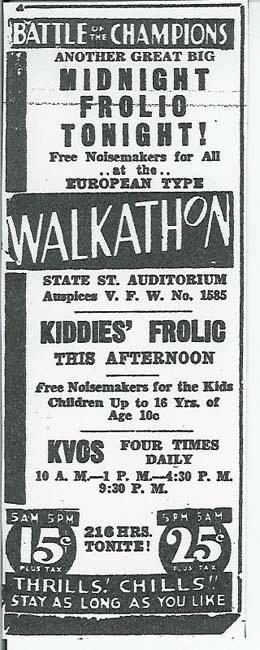On August 26, 1935, a dance marathon/walkathon closes in Bellingham after 900 hours (about 37 days). The contest takes place despite a 1931 Bellingham City Council Ordinance prohibiting such contests within Bellingham city limits. Dance marathons are human endurance contests in which couples dance almost non-stop for hundreds of hours (as long as a month or two), competing for prize money.
Dance marathons (also called walkathons) arose during the 1920s and remained both popular and profitable throughout the 1930s. Twenty-five cents bought a ringside seat for unlimited hours in which to watch exhausted dancers compete to outlast one another and win prize money. Despite their appeal to some segments of the public, the events aroused great protest from churches, women’s groups, and police officers. Movie theater owners, whose profits diminished when a dance marathon siphoned off their audiences, also objected to the marathons. The events existed outside the realm of polite society, often censured and frequently banned.
The 1935 Bellingham marathon took place at the State Street Auditorium, as had a 1931 marathon that prompted the City Council ban. Like the 1931 show, the local chapter of the Veterans of Foreign Wars sponsored it. Hal J. Ross was the event’s promoter.
Hal Ross, Veteran Promoter
Ross was nationally known as a dance marathon promoter, and was himself a member of the Veterans of Foreign Wars by virtue of his service as a commissioned officer during World War I. It was undoubtedly Ross’s veteran status, combined with his sterling reputation as the nation’s most reliable promoter who always paid his debts, which enabled the 1935 Bellingham dance marathon to take place despite the local ban on such events. Ross’s marathon was the only such event staged in Bellingham since the ordinance prohibiting endurance contests went into effect on January 28, 1931, causing the 1931 marathon to end prematurely without a winner or any award of prize money.
Of the 10 or so professional dance marathon promoters most active during the 1930s, Hal Ross was the most sophisticated at manipulating the local press. Newspapers in towns where his shows were staged routinely covered the events every day without fail, and Ross gave his press representatives a 20 percent stake in his profits to ensure that this was so. It is notable, then, that the 1935 Bellingham marathon received scant press and only one week of paid display advertising. Perhaps the Bellingham Evening Herald purposely boycotted the event.
Dynamite Sprints
Although Ross was considered to run a fair, honest marathon, his events were noted for their brutal elimination events, including the Ross-invented "dynamite sprints," in which exhausted competitors sprint-raced against one another. In dynamite sprints couples could be taped together or required to run backwards.
As was common in dance marathons, the contestants consisted mainly of professional marathoners known as ‘horses’ for their ability to last through the grueling weeks of competition. Ross kept a stable of these professionals, paying their travel expenses to his shows. “Up to $1750 in cash prizes,” Ross’s advertisement in the entertainment industry publication The Billboard read shortly before the July 18, 1935, start of the Bellingham show. “Hi-Class Couples, Write or Wire” (July 13, 1935). Hopeful amateurs, often desperate for the prize money, completed the field.
Thrills! Chills!
During the day dance marathons consisted of little more than exhausted shuffling, but evening audiences were guaranteed vaudeville-type entertainment and a variety of special events. During the one week when the Bellingham Evening Herald accepted paid advertisements for the contest, the evening amusements included:
“Another Great Big Midnight Frolic Tonight! Free noisemakers for all” (July 27, 1935)
“Sunday Night Hi-Jinks … the Hill Billy Band” (July 29, 1935)
“A Riot of Fun -- Amateur Night Tonight!" (July 30, 1935)
“Bicycle Races Tonight! For Laugh Purposes Only!” (July 31, 1935)
“Pal Night Tonight -- 2 admitted for the price of one" (August 2, 1935)
"Walkathon Stock Company’s’ Latest and Funniest Laugh Riot: ‘The Dying Gladiators’”
“Square Dance Contest Tonight … Bigger and Better!” (August 2, 1935)
Each advertisement reminded the audience: “Thrills! Chills! Stay as Long As You Like!”
Sprinting to the Finish Line
Reduced community support, including “widespread protest from a large group of citizens and the ministers of the city” resulted in a reduced take at the box office. On August 27, 1935, after five weeks and four days of competition, the floor judges instituted a continuous sprint. This required all of the remaining contestants (two couples and one soloist) to run full out until all but one pair were eliminated. “Harry Hanby and Gean [Jean] Moon … were declared the winners. Tad Black and Betty Lee Doria and Tommy Gardner … went down only a few minutes apart” (Bellingham Evening Herald, August 27, 1935).
The Veterans of Foreign Wars received $450, Harry Hanby and Jean Moon, $420 each; Tad Black and Betty Lee Doria, $210 each; Tommy Gardner and Billie Farmer, $105 each; Millie Bramer and Tom Day, $65 each; Marjorie Lingo, $20.94.” The winners had danced for 900 hours (about 37 days). The customary Victory Ball, in which winners mixed with the fans, was called off.
At the time, Hal Ross was also producing another dance marathon in Fife near Tacoma. That show proved much more profitable. The Billboard noted that “The Ross Units, from Bellingham and Tacoma, left for their next location in a leased air-cooled coach, with a special baggage car for equipment” (September 7, 1935). Thus Ross, his professional contestants, emcees, floor judges, trainers, and press representatives moved on in style.
Bellingham does not appear to have suffered through another dance marathon. In March 1937, the state of Washington banned dance endurance contests statewide.

